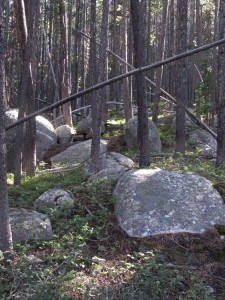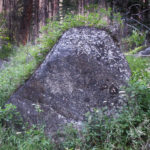 Crossing the glacial moraine that dams Racetrack Lake above Deerlodge, we make our way to the trailhead at the lake’s inlet. We are soon ascending through a hummucky, rock strewn forest of lodgepole pines. Sticks and stones won’t break our bones as we make our careful way up the trail, but climbing over deadfall and around the boulders will surely make our bones ache tomorrow morning. We are traveling through a forest of erratics–rocks resting far from the source, carried from the high peaks with their sharp ridges on a sheet of glacial ice and left behind as the ice age ended.
Crossing the glacial moraine that dams Racetrack Lake above Deerlodge, we make our way to the trailhead at the lake’s inlet. We are soon ascending through a hummucky, rock strewn forest of lodgepole pines. Sticks and stones won’t break our bones as we make our careful way up the trail, but climbing over deadfall and around the boulders will surely make our bones ache tomorrow morning. We are traveling through a forest of erratics–rocks resting far from the source, carried from the high peaks with their sharp ridges on a sheet of glacial ice and left behind as the ice age ended.
We too are a group of erratics, most of us from other places, brought here by jobs or dreams of living just a bit closer to the bedrock, seeking out a place where we might be surrounded by space and wildness rather than the press of other people and commerce. Only two or three of us grew up in the surrounding valleys and their stories of those ranching years and their knowledge of the flowers and birds helps ground the rest of us to our chosen homeland.
We think of rocks as steadfast and immovable, but each of these giant boulders is a monument to change. Born in a liquid fire, they were expelled from the earth’s crust by a force of unfathomable power, cooling slowly over time, then squeezed and crushed and molded by tremendous pressures, thrust up in the violent collision of tectonic plates and rising thousands of feet into the sky. Then they were sheared from their mother mountain by rains and freezes and broken by tons of glacial ice, scraping and filing their rough edges as they were carried down the mountain on the glacier’s back. Even when the ice melted and these erratics came to rest in what would, aeons on become a forest, their stories did not end. The seeds and spores of lichen and moss were brought by the wind from far-off places and began the slow process of burrowing down into the rock’s skin, breaking it apart, creating pockets of loose soil where grasses and then small bushes could get a foothold, maybe even a tree might reach its root tentacles down into cracks and crevices, feeding on the essence of the boulder.
 “Stone is the face of patience,” Mary Oliver says. Yes, these erratics are the face of patience, but their story is one of constant change, being shaped by powerful forces, no will of their own, no clinging to any one state, no concept of being a part of something bigger or broken apart from that, no sense of being a separate thing, no self. Only a patient yielding to impermanence. How can we imagine such a thing?
“Stone is the face of patience,” Mary Oliver says. Yes, these erratics are the face of patience, but their story is one of constant change, being shaped by powerful forces, no will of their own, no clinging to any one state, no concept of being a part of something bigger or broken apart from that, no sense of being a separate thing, no self. Only a patient yielding to impermanence. How can we imagine such a thing?
